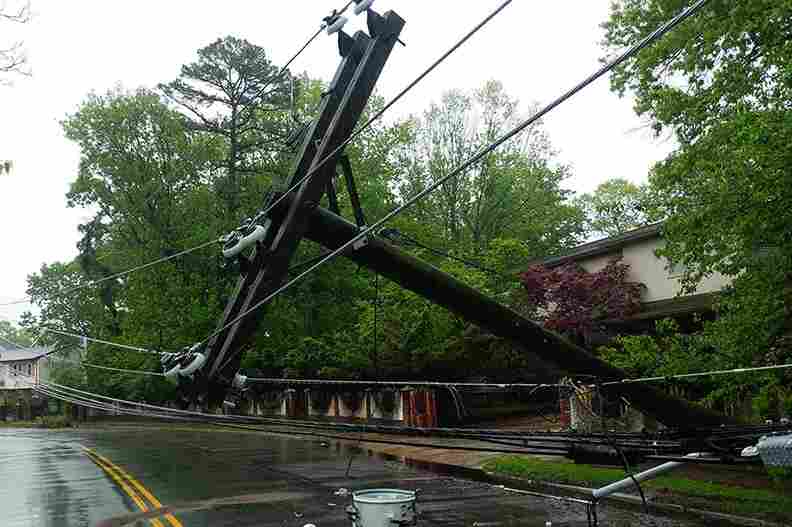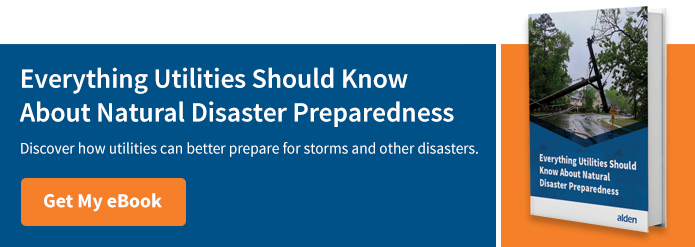How Utilities Can Prepare for Severe Weather with Storm Hardening

The decision to implement a storm hardening program is a big step for any utility company. Large-scale storm hardening can be cost-prohibitive and may take years to complete, especially for larger utilities responsible for millions of assets.
Companies that undertake storm hardening prep activities usually do so because they have found not taking preventive action may actually be worse in the long run. Infrastructure that has unacceptable vulnerabilities to weather events, like major hurricanes or blizzards, could set the stage for enormous costs and prolonged outages.
Each utility is different, so every storm hardening plan will be unique to the utility’s needs, goals, geography, resources, and vulnerabilities. For example, a coastal utility has different needs than an inland utility. Companies in areas prone to heavy ice storms have concerns that those in warmer climates do not.
Storm hardening is a catch-all term for a variety of physical improvements that make utility infrastructure less vulnerable to extreme weather. Utilities are giving greater consideration to these measures than in the past because extreme weather events are more common, and the potential costs have risen tremendously, as outlined in Utility Dive. Reports from the U.S. Department of Energy and the Edison Electric Institute outline some of the major types of storm hardening and the ways they benefit utilities.
Pole Replacement
The National Oceanic and Atmospheric Administration (NOAA) recommends that utility poles in coastal areas be able to withstand winds of at least 145 mph. For inland utilities, a standard of 130 mph or less may be adequate.
Utilities may look at replacing wooden poles, especially in the most vulnerable areas, with more wind-resistant concrete or steel poles. A pole-by-pole structural analysis can be performed using comprehensive data collection methods and computer modeling to give each pole a pass-or-fail rating.
Many utilities have damaged, rotting, or otherwise structurally compromised poles currently in place. Recent storms have proven the high vulnerability of double poles – instances in which a new pole has been set, but the old pole has not been removed.
Reinforcement of Existing Assets
Short of replacement, a utility may choose to treat existing poles to strengthen them or add guy wires for reinforcement.
Transmission lines may be reinforced to make them stronger. Special coatings are available for transmission and distribution equipment that shed water quickly and simplify ice removal.
Selective Undergrounding
While it can be expensive and disruptive to move utility lines from above ground to below, if it is possible, this can often be one of the best ways to protect critical parts of a company’s infrastructure. Undergrounding may not be suitable in some areas, such as those prone to flooding.
Sections of line that serve densely populated areas or that supply power to police departments, fire stations, hospitals, and other crucial public institutions are among those most often targeted for undergrounding.
Flood Protection
Preventing floodwaters from damaging equipment may require one or more of the following actions:
- Building floodwalls or moats
- Reinforcing or restoring natural barriers to flooding
- Elevating substations and other equipment to make them harder for floodwaters to reach
- Replacing existing equipment with new equipment designed to withstand submersion
- Weatherproofing facilities and equipment using coatings or sealants
Technological Solutions and Grid Diversity
Making the grid more flexible is also a kind of storm hardening. Evolving technology continues to offer protections that can limit power outages and allow quicker restoration to undamaged sections of line. These include automated monitoring, smart meters, switches, reclosers, and sectionalizers.
Microgrids, including those relying on solar and wind-generated power, can serve as backups to the main grid during outages.
First Step: Evaluate Your Assets
A vulnerability assessment is essential before a company decides whether the benefits of storm hardening justify the costs, and what types of storm hardening best meet its goals and needs. With the technology available today, such assessments can be performed more quickly and produce better information than in the past. Alden, for example, recently used advanced LIDAR data collection and streamlined back-office loading analysis to cut the time typically required to perform structural analysis of utility poles for one of our clients.
More utilities are choosing to make storm hardening part of severe weather preparedness plans. This is not a one-size-fits-all proposition. Targeted improvements based on reliable data make a real difference.
Alden is extending its nationally-recognized expertise in joint use data collection and management to include storm hardening assessments. Our joint use management platform, Alden One®, is the best tool available to simplify the process of keeping crucial data accessible, up to date, and ready to use.
Alden One® streamlines coordination of time-sensitive operations involving multiple utility departments, joint use partners, contractors, subcontractors, and other interested parties.
Working together, we can build a stronger, more resilient grid to face the growing challenges posed by extreme weather. If you’d like more information about what Alden brings to the table, click here to contact a product specialist.
To learn more about how utilities can prepare for storms and other natural disasters, click the link below to download our eBook, Everything Utilities Should Know About Natural Disaster Preparedness.
